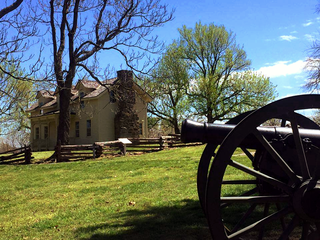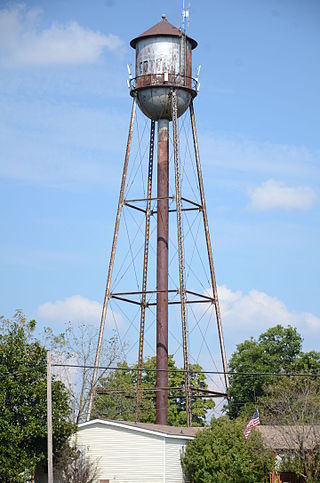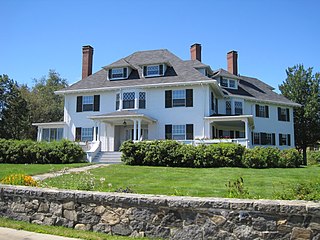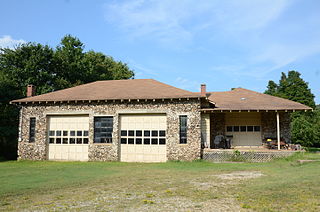
Lincolnton is a city in Lincoln County, North Carolina, United States, within the Charlotte metropolitan area. The population was 10,486 at the 2010 census. Lincolnton is northwest of Charlotte, on the South Fork of the Catawba River. The city is the county seat of Lincoln County, and is the only legally incorporated municipality wholly within the county.

The Old Ship Church is a Puritan church built in 1681 in Hingham, Massachusetts. It is the only surviving 17th-century Puritan meetinghouse in America. Its congregation, gathered in 1635 and officially known as First Parish in Hingham, occupies the oldest church building in continuous ecclesiastical use in the United States. On October 9, 1960, it was designated a National Historic Landmark and on November 15, 1966, it was added to the National Register of Historic Places.

The Menard–Hodges site (3AR4), is an archaeological site in Arkansas County, Arkansas. It includes two large platform mounds as well as several house mounds. It is the type site for the Menard phase, a protohistoric Mississippian culture group.

The Arkansas Delta is one of the six natural regions of the state of Arkansas. Willard B. Gatewood Jr., author of The Arkansas Delta: Land of Paradox, says that rich cotton lands of the Arkansas Delta make that area "The Deepest of the Deep South."

The Charles Young Buffalo Soldiers National Monument, a National Monument of the United States, commemorates the life of Charles Young (1864-1922), an escaped slave who rose to become a Buffalo Soldier in the United States Army and its first African-American colonel. It is located on United States Route 42 in Wilberforce, Ohio, in a house purchased by Young in 1907 that was designated a National Historic Landmark in 1974. The monument is administered by the National Park Service; the house is open by appointment for tours.

Hook Windmill, also known as Old Hook Mill, is a historic windmill on North Main Street in East Hampton, New York. It was built in 1806 and operated regularly until 1908. One of the most complete of the existing windmills on Long Island, the windmill was sold to the town of East Hampton in 1922. The building was listed on the National Register of Historic Places in 1978 and is part of the North Main Street Historic District. The mill was renamed the "Old Hook Mill" and is open daily to visitors.

The Prairie Grove Battlefield State Park is an Arkansas state park located in Prairie Grove. It commemorates the Battle of Prairie Grove, fought December 7, 1862, during the American Civil War. The battle secured northwestern Arkansas for the Union.

Lakeport Plantation is a historic antebellum plantation house located near Lake Village, Arkansas. It was built around 1859 by Lycurgus Johnson with the profits of slave labor. The house was restored between 2003 and 2008 and is now a part of Arkansas State University as a Heritage site museum.

The Hampton Waterworks is a historic site located in Hampton, Arkansas. Completed in 1937, it is the only surviving example of a Public Works Administration-built waterworks in Calhoun County. The site contains a good example of a 1930s-era elevated steel water tower, built by the Pittsburgh-Des Moines Steel Company. The site was added to the National Register of Historic Places in 2006.

The Cotter water tower is a historic elevated steel water tower located in Cotter, Arkansas. It was constructed in 1935 by the Pittsburgh-Des Moines Steel Company, as part of the development of the local water supply system by the Public Works Administration. The tower was added to the National Register of Historic Places in 2007, as part of a multiple-property listing that included numerous other PWA-era projects in Arkansas, under the heading “An Ambition to Be Preferred: New Deal Recovery Efforts and Architecture in Arkansas, 1933-1943.”

The Cotton Plant water tower is a historic elevated steel water tower located in Cotton Plant, Arkansas. It was built in 1935 by the Pittsburgh-Des Moines Steel Company in conjunction with the Public Works Administration as part of a project to improve the area's water supply. It was added to the National Register of Historic Places in 2008, as part of a multiple-property listing that included numerous other New Deal-era projects throughout Arkansas.

The De Valls Bluff Waterworks is a historic public water supply facility at Rumbaugh and Hazel Streets in De Valls Bluff, Arkansas. It contains a 1930s-era elevated steel water tower, built in 1936 by the Pittsburgh-Des Moines Steel Company in conjunction with the Public Works Administration as part of a project to improve the local water supply. It was added to the National Register of Historic Places in 2007, as part of a multiple-property listing that included numerous other New Deal-era projects throughout Arkansas. The property also contains several non-contributing buildings, including a shed, aeration chamber and water tank.

Wade Hampton Hicks House is a historic home located at Hartsville, Darlington County, South Carolina. It was built in 1901, and expanded with a second story in 1919. It is a two-story, three bay, rectangular American Craftsman inspired residence, set upon a brick foundation. It has a hipped roof with wide overhangs and exposed rafter tails and a one-story hipped roof wraparound porch. Also on the property is a small wooden carriage house/smokehouse, constructed about 1901. It was the home of Wade Hampton Hicks (1874-1945), prominent Hartsville farmer and businessman who founded W.H. Hicks and Son Feed and Seed Company.

The Little Boar's Head Historic District encompasses an area of summer resort and beachfront properties in North Hampton, New Hampshire. Located on New Hampshire's seacoast roughly between North Hampton State Beach and Bass Beach, the district is almost entirely residential, consisting mainly of houses built as summer vacation spots in the late 19th and early 20th centuries, with associated beachfront amenities. The district was listed on the National Register of Historic Places in 1999.
Hampton Springs Cemetery is a cemetery in rural Dallas County, Arkansas, at the junction of county roads 425 and 427, near the city of Carthage. The cemetery is divided into two sections, one in which traditional European grave markers predominate, and another section in which graves are marked by a local adaptation of African burial customs.

The Gov. Meshech Weare House is a historic house on Exeter Road in Hampton Falls, New Hampshire. It was built in 1723, and is notable as the home of Meshech Weare, the first Governor of New Hampshire after it declared independence from the British crown. It was listed on the National Register of Historic Places in 1973.

The Aggie Workshop is a historic former school building on Marion County Road 5010 in Bruno, Arkansas. It is a single-story L-shaped structure, built out of local stone and topped by a hip roof with Craftsman-style exposed rafter tails. The WPA-approved building was built in 1935 by the Lincoln Aggie Club and was used as a vocational stone and cement workshop, as part of the local Bruno Agricultural School. A cement swimming pool, contemporaneous to the building's construction, is located in the crook of the L.

The Seed Warehouse No. 5 is a historic seed storage facility, now located on the grounds of the Plantation Agriculture Museum, a state park in Scott, Arkansas. It is a long rectangular structure, with walls that slope inward as they rise to a gable roof. The roof is topped by a series of gabled cupolas, each with windows and louvered openings. The main entrance is at one end, in a projecting gabled section. All of the exterior walls are corrugated metal. Built in 1948 by a prominent local cotton farmer, it is a well-preserved example of a modern mid-20th century cotton seed storage facility. It was acquired by the state in 1985 for the museum, underwent restoration in 2008, and now houses museum exhibits.
The Memphis to Little Rock Road was a settlement road constructed between 1819 and Reconstruction in Arkansas. The project was one of many internal improvements to assist settlement of the Old Southwest as well as military defense of the Arkansas Territory.

















